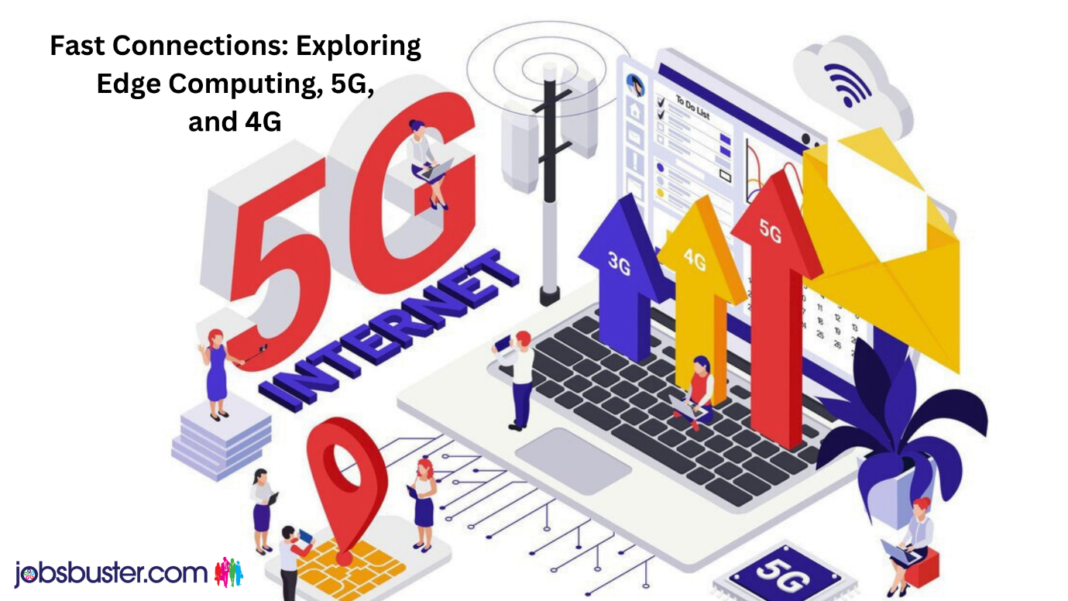Introduction
In our fast-paced world, where speed and reliability are crucial, technologies like edge computing, 5G, and 4G have revolutionized how we connect and access information. These advanced technologies play a vital role in providing fast connections, improving user experiences, and enabling the seamless integration of numerous devices. In this article, we will explore the world of edge computing, 5G, and 4G, understanding what they do, their benefits, and how they impact our digital lives.
Understanding Edge Computing
Edge computing means processing data closer to where it’s generated or used, rather than sending it to a distant data centre. This approach reduces delays and improves the performance of applications and services.
One of the key advantages of edge computing is its support for real-time applications that need immediate responses, like augmented reality (AR), virtual reality (VR), and autonomous vehicles. By processing data closer to the users or devices, edge computing reduces the time it takes for data to travel back and forth to a central server, resulting in faster response times and better user experiences.
Edge computing also plays a crucial role in enabling the Internet of Things (IoT) devices. With billions of IoT devices expected to be deployed in the future, edge computing provides the infrastructure to handle the large amounts of data generated by these devices, while minimizing delays and bandwidth requirements.
Unleashing the Power of 5G
5G is the fifth-generation wireless technology that brings remarkable speed, capacity, and low latency. Compared to the previous generation, 4G, 5G offers a significant improvement, making it ideal for applications that require high bandwidth and emerging technologies.
One of the key features of 5G is its ultra-low latency, which means there is minimal delay between sending and receiving data. This near real-time responsiveness enables applications such as remote surgery, autonomous vehicles, and immersive gaming experiences. 5G achieves low latency by using higher frequency bands, increased network density, and advanced antenna technologies.
Moreover, 5G delivers incredible speeds, reaching up to 20 gigabits per second (Gbps) under ideal conditions. This fast speed allows for seamless streaming of high-definition content, rapid file downloads, and smooth video conferencing. With the widespread deployment of 5G networks, we can expect a significant boost in productivity and innovation across various industries.
Evolving from 4G to 5G
To understand 5G, it’s important to know about its predecessor, 4G. 4G, also known as LTE, has been the primary mobile connectivity technology for the past decade, offering faster speeds and more reliable connections compared to 3G.
4G networks have been the foundation for many services we use today, such as video streaming, mobile gaming, and cloud-based applications. However, as the demand for data-intensive applications increased, the limitations of 4G became evident, leading to the development of 5G.
5G operates on a higher frequency spectrum, which allows for increased network capacity and reduced congestion. This improvement is crucial for supporting the growing number of connected devices and the data they generate. Additionally, 5G networks use advanced beamforming techniques, enabling more efficient use of available bandwidth and improving signal strength.
The Future of Connectivity
The convergence of edge computing, 5G, and 4G is shaping the future of connectivity, opening doors to innovation and transforming industries.
With edge computing and 5G working together, we can expect the rise of smart cities, autonomous vehicles, and a fully connected IoT ecosystem. Edge computing enables real-time monitoring and optimization of resources for smart cities. Autonomous vehicles can leverage the low latency and high bandwidth of 5G to communicate with each other and their surroundings, making transportation safer and more efficient.
Furthermore, the combination of edge computing and 5G enables immersive AR and VR experiences. By bringing processing power closer to the user, the lag and latency issues that plagued these technologies in the past can be significantly reduced, resulting in seamless and immersive digital experiences.
Conclusion
The convergence of edge computing, 5G, and 4G is a significant milestone in our quest for faster and more reliable connections. Edge computing brings processing power closer to the edge of the network, reducing delays and enabling real-time applications. 5G, with its impressive speeds and low latency, unlocks new possibilities for innovation and transformative technologies. And while 4G has been the backbone of mobile connectivity, 5G is poised to revolutionize how we interact with the digital world.
As these technologies continue to evolve, we can look forward to a future where smart cities thrive, autonomous vehicles dominate the roads, and immersive experiences become the norm. Fast connections are no longer a luxury but a necessity for progress, and edge computing, 5G, and 4G are the driving forces behind this digital transformation.
Author Bio:
Shruti Singhai is a science graduate and a digital marketing professional with expertise in Search Engine Optimization (SEO). Currently working as an SEO Specialist at Jobsbuster, a part of AMG. She loves writing about technology. she honed her skills in SEO, content creation, and social media marketing. In her free time, Shruti enjoys reading about the latest trends, Travelling, & listening to music.








